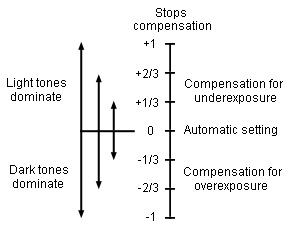Exposure bracketing is a simple technique for ensuring that an image is captured at the ideal exposure. Modern cameras have very sophisticated exposure determination systems and set the best exposure possible in the large majority of cases. However, some circumstances may lead to significant over exposure or underexposure. Where a scene is dominated by light tones, such as a snowscape, automatic metering systems are inclined to underexpose the image. Similarly, scenes consisting largely of darker tones may be overexposed.
 Where doubt exists, bracketing provides a simple solution. The simplest method of achieving a sequence of bracketed images is to use the camera's exposure compensation facility to take images at exposures either side of that set by the automatic system. Most exposure compensation systems allow the automatically-set exposure to be overridden, in increments of a third or a half a stop, up to about three or four stops in either direction. It is consequently a simple matter to take a shot at the normal exposure set by the automatic system, and then take a further two shots using exposure compensation of perhaps plus and minus half a stop. In cases where the exposure error is predictable, such as in the case of a snow scene, exposure compensation values can can all typically be set to increase exposure relative to automatic setting. The exposure for a snow scene might therefore be initially set to the automatic setting, and then increased in half-stop increments by up to one or two stops. This more or less guarantees that one of the images will be ideally exposed.
Where doubt exists, bracketing provides a simple solution. The simplest method of achieving a sequence of bracketed images is to use the camera's exposure compensation facility to take images at exposures either side of that set by the automatic system. Most exposure compensation systems allow the automatically-set exposure to be overridden, in increments of a third or a half a stop, up to about three or four stops in either direction. It is consequently a simple matter to take a shot at the normal exposure set by the automatic system, and then take a further two shots using exposure compensation of perhaps plus and minus half a stop. In cases where the exposure error is predictable, such as in the case of a snow scene, exposure compensation values can can all typically be set to increase exposure relative to automatic setting. The exposure for a snow scene might therefore be initially set to the automatic setting, and then increased in half-stop increments by up to one or two stops. This more or less guarantees that one of the images will be ideally exposed.
Some cameras have sophisticated automatic bracketing facilities which allow photographers to program bracketing regimes in advance. Exposures might typically be set equal to, above and below the automatically-determined value.






